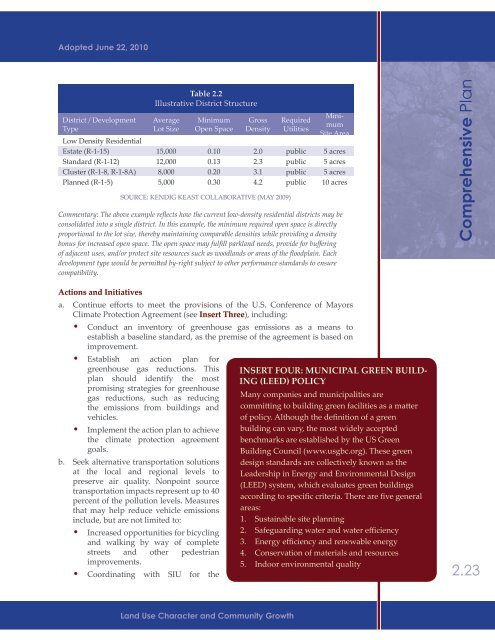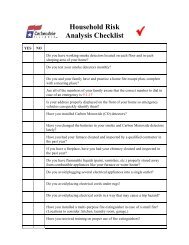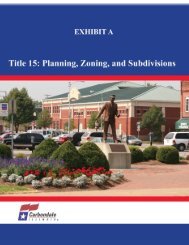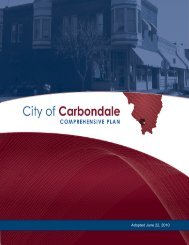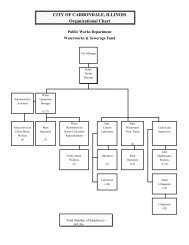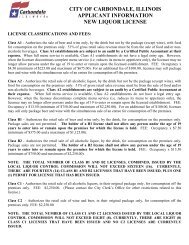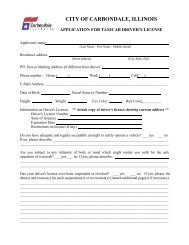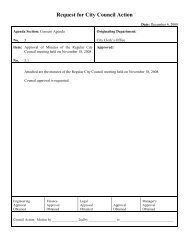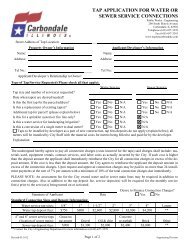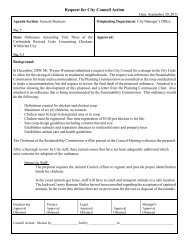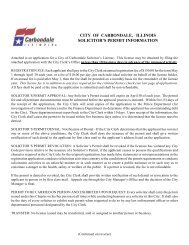Comprehensive Plan - Carbondale, IL
Comprehensive Plan - Carbondale, IL
Comprehensive Plan - Carbondale, IL
- No tags were found...
You also want an ePaper? Increase the reach of your titles
YUMPU automatically turns print PDFs into web optimized ePapers that Google loves.
Adopted June 22, 2010District / DevelopmentTypeTable 2.2Illustrative District StructureAverageLot SizeMinimumOpen SpaceGrossDensityRequiredUtilitiesMinimumSite AreaLow Density ResidentialEstate (R-1-15) 15,000 0.10 2.0 public 5 acresStandard (R-1-12) 12,000 0.13 2.3 public 5 acresCluster (R-1-8, R-1-8A) 8,000 0.20 3.1 public 5 acres<strong>Plan</strong>ned (R-1-5) 5,000 0.30 4.2 public 10 acresSOURCE: KENDIG KEAST COLLABORATIVE (MAY 2009)Commentary: The above example reflects how the current low-density residential districts may beconsolidated into a single district. In this example, the minimum required open space is directlyproportional to the lot size, thereby maintaining comparable densities while providing a densitybonus for increased open space. The open space may fulfill parkland needs, provide for bufferingof adjacent uses, and/or protect site resources such as woodlands or areas of the floodplain. Eachdevelopment type would be permitted by-right subject to other performance standards to ensurecompatibility.<strong>Comprehensive</strong> <strong>Plan</strong>Actions and Initiativesa. Continue efforts to meet the provisions of the U.S. Conference of MayorsClimate Protection Agreement (see Insert Three), including:• Conduct an inventory of greenhouse gas emissions as a means toestablish a baseline standard, as the premise of the agreement is based onimprovement.• Establish an action plan forgreenhouse gas reductions. Thisplan should identify the mostpromising strategies for greenhousegas reductions, such as reducingthe emissions from buildings andvehicles.• Implement the action plan to achievethe climate protection agreementgoals.b. Seek alternative transportation solutionsat the local and regional levels topreserve air quality. Nonpoint sourcetransportation impacts represent up to 40percent of the pollution levels. Measuresthat may help reduce vehicle emissionsinclude, but are not limited to:• Increased opportunities for bicyclingand walking by way of completestreets and other pedestrianimprovements.• Coordinating with SIU for theINSERT FOUR: MUNICIPAL GREEN BU<strong>IL</strong>D-ING (LEED) POLICYMany companies and municipalities arecommitting to building green facilities as a matterof policy. Although the definition of a greenbuilding can vary, the most widely acceptedbenchmarks are established by the US GreenBuilding Council (www.usgbc.org). These greendesign standards are collectively known as theLeadership in Energy and Environmental Design(LEED) system, which evaluates green buildingsaccording to specific criteria. There are five generalareas:1. Sustainable site planning2. Safeguarding water and water efficiency3. Energy efficiency and renewable energy4. Conservation of materials and resources5. Indoor environmental quality2.23Land Use Character and Community Growth


